自主水下航行器(Autonomous Underwater Vehicle,AUV)是一种可以根据预设任务,在水下自主航行的无人潜水器,具有自主航行、自主导航、自主探测的功能[1-4]。近年来随着AUV能源、导航、自动控制技术等方面的提升,AUV作为移动测量平台逐渐被应用于海洋环境监测、水下目标识别、水底地形探测等领域[5-7]。由于AUV平台较小,其自噪声严重制约搭载于平台的声呐系统性能。如何有效控制AUV的自噪声,对于平台声呐系统实现最佳性能具有重要实际意义。
AUV的自噪声主要由航行器舵机等产生的机械噪声、螺旋桨噪声和水动力噪声几部分组成[8-9]。文中的AUV典型航速为3 kn,航速较低,噪声主要由机械振动、螺旋桨噪声产生[10],本文主要对舵机等转动产生的机械噪声、螺旋桨噪声进行分析。通过AUV平台与声呐系统一体化控噪设计,利用机械降噪、隔振材料、智能控制等手段,对AUV进行系统性噪声控制。
1 AUV自噪声分析及控制 1.1 自噪声分析本文AUV推进系统采用单推进器、4个舵机驱动的方式,其结构如图1所示。推进器电机固定于舱体内部,通过联轴器、传动轴驱动螺旋桨转动,产生推力;4个舵机固定于舱体内部,通过轴杆驱动舵板转动,控制方向和升沉。
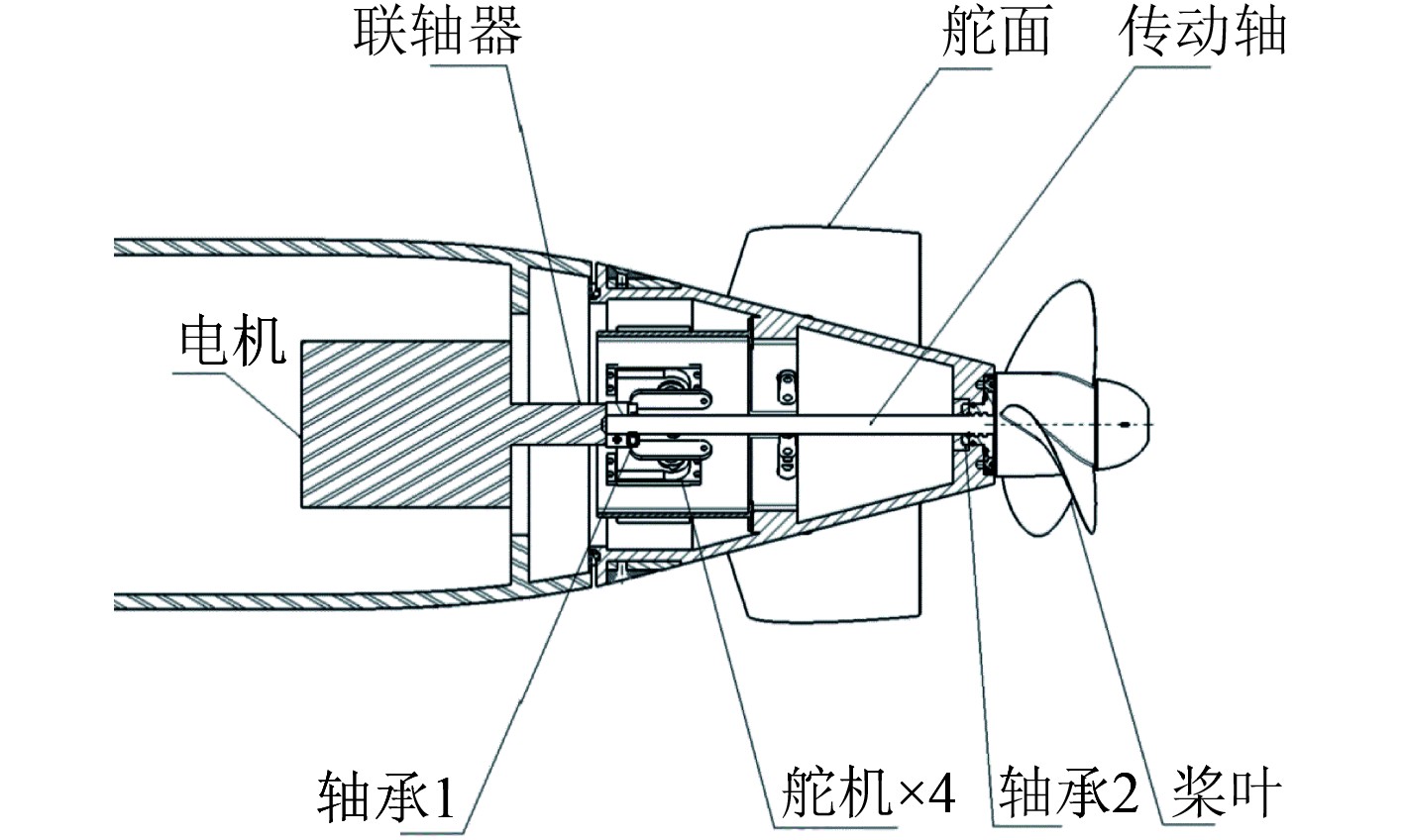
|
图 1 AUV推进系统结构图 Fig. 1 Propulsion system structure diagram |
首先在室内对推进器噪声、舵机噪声进行测试。推进器噪声分为电机噪声、电机加传动轴的噪声,以及电机加传动轴和螺旋桨的噪声。电机噪声指拆除传动轴和螺旋桨,只将电机固定在舱体内工作所产生的噪声;电机加传动轴噪声指电机接上传动轴后工作所产生的噪声;电机加传动轴和螺旋桨噪声指电机接上传动轴,并且安装螺旋桨后工作所产生的噪声。为了测试不同部件的噪声,本文对这几部分噪声单独测试。声学测量设备为麦克风和一套数据采集系统,其中数据采集系统采样频率52 kHz。室内噪声测试结果已经做归一化处理。
图2为电机在不同转速下(分别为300 ,400和500 r/min)的噪声,可以发现在15 kHz附近有一个较强的单频信号,其频率值不随转速的改变而发生变化,其幅度会随着转速的增大而增大。
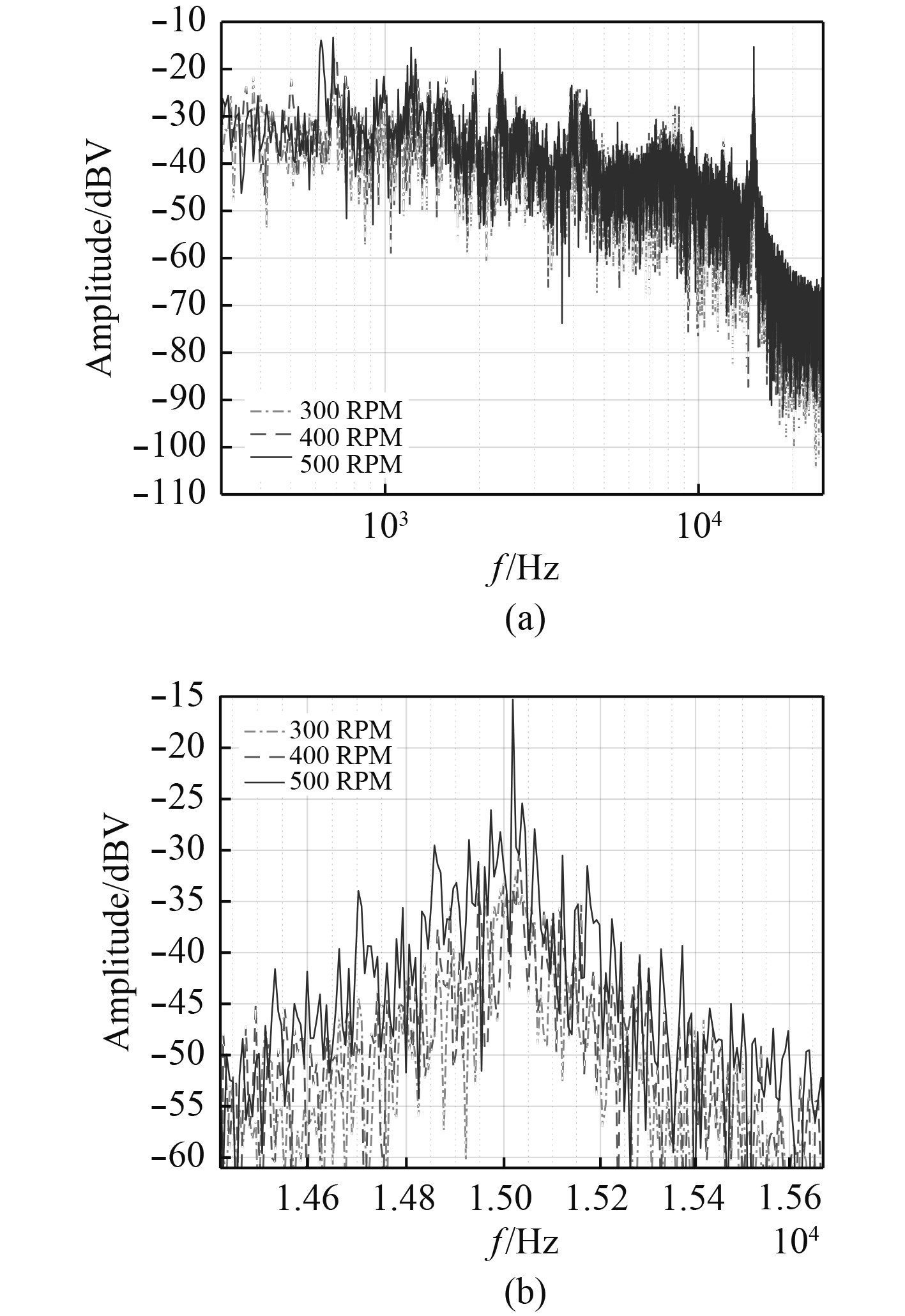
|
图 2 不同转速下电机噪声、幅度已归一化处理 Fig. 2 The motor noise at different speeds, the amplitude has been normalized |
图3比较了推进系统电机噪声、电机加传动轴的噪声,以及电机加传动轴和螺旋桨的噪声,电机转速500 r/min。可以发现,3种情况总体噪声特性基本一致,加装传动轴、螺旋桨后在低频处的噪声会增大。由于在空气中测试,螺旋桨转动没有与水体接触的噪声,所以相比于只安装传动轴,噪声特性变化不大,需要在湖上进一步测试。
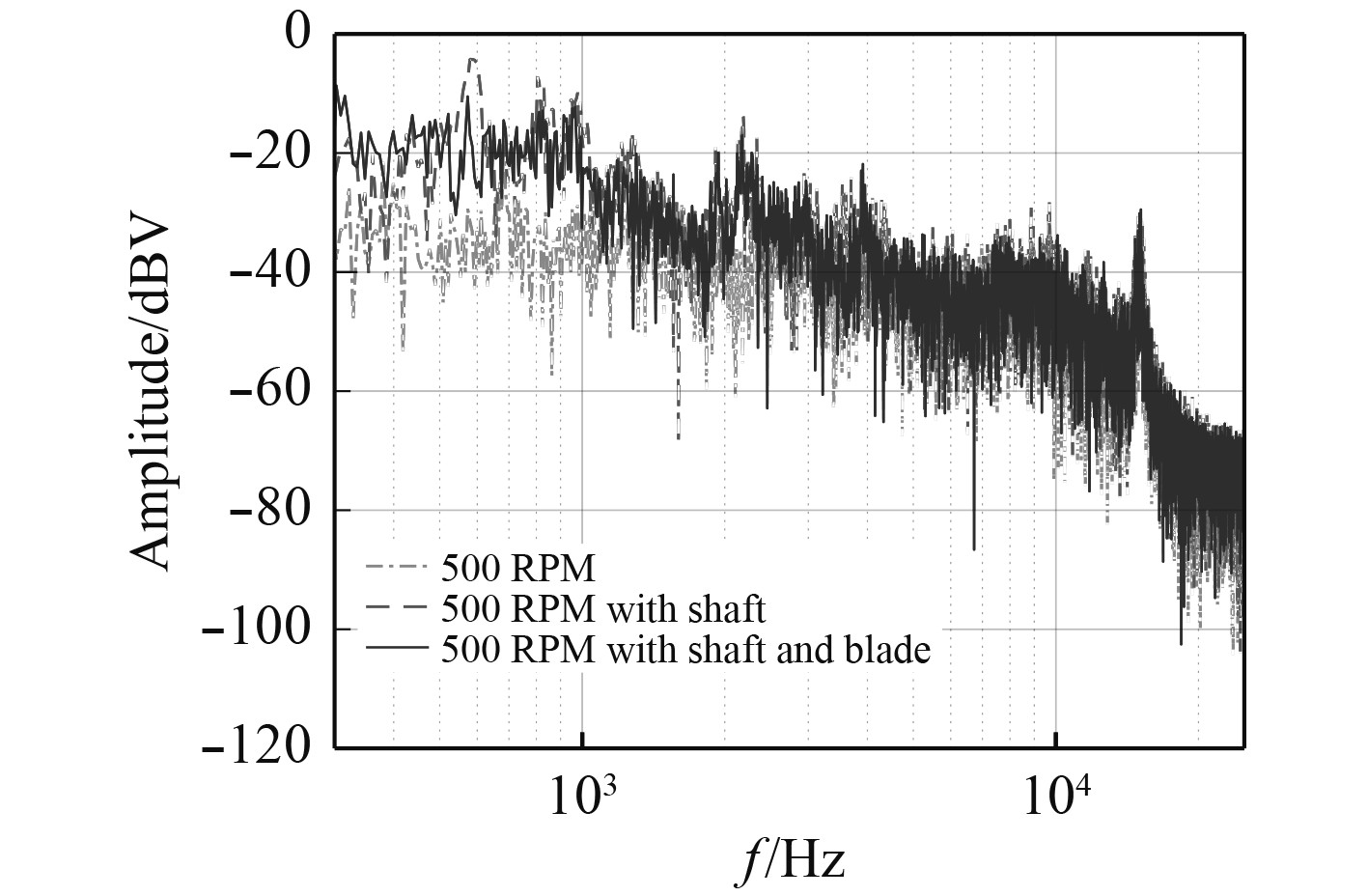
|
图 3 推进系统电机噪声、电机加传动轴噪声,以及电机加传动轴和螺旋桨噪声比较 Fig. 3 Comparison of propulsion system motor noise, motor plus drive shaft noise, and motor plus drive shaft and propeller noise |
对舵机噪声进行测试,如图4所示。这是转舵18°的噪声测量结果,可以发现噪声频带较宽,并且在低频区域(0.5~1 kHz)噪声尤为明显。
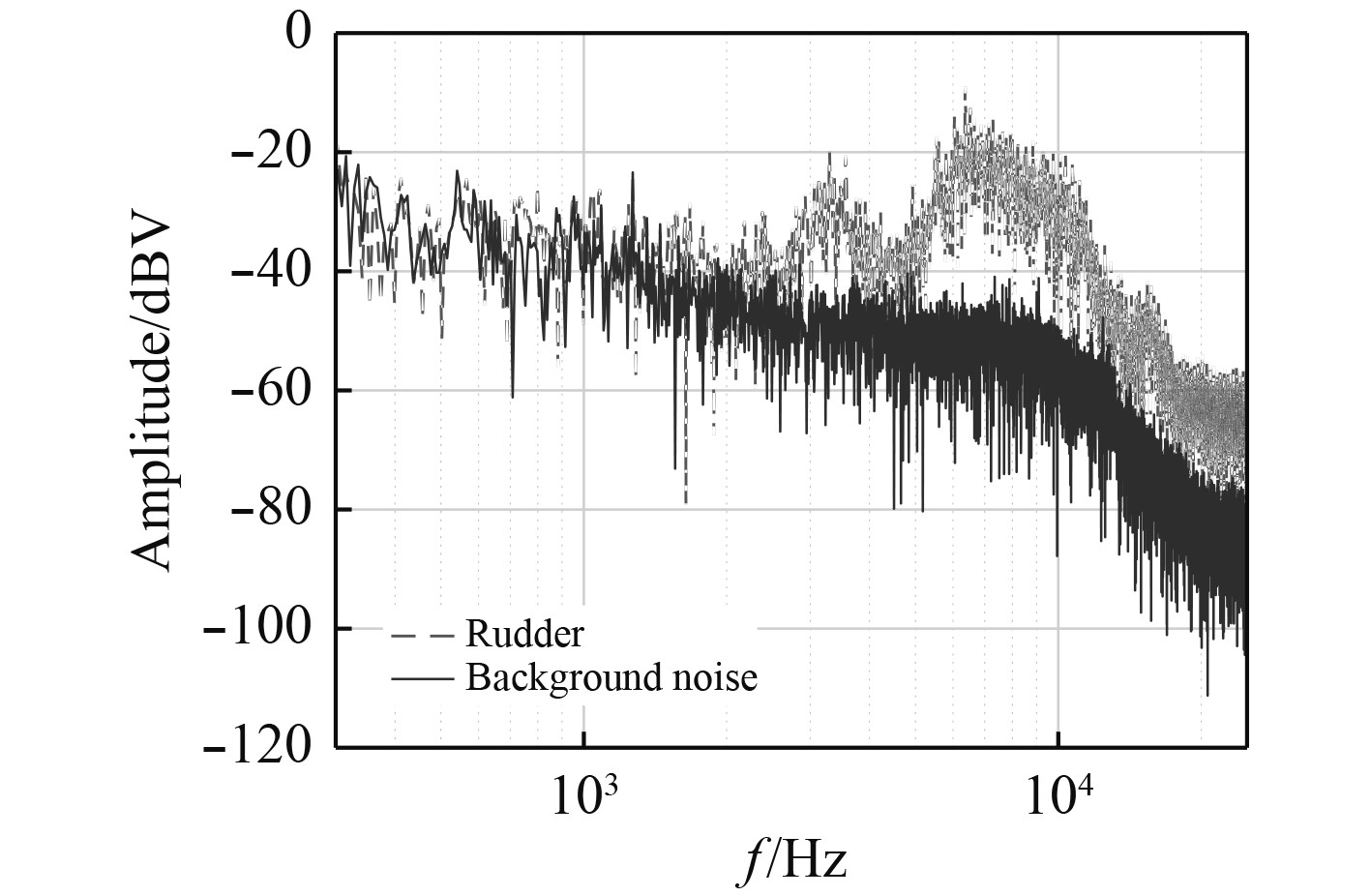
|
图 4 舵机转舵噪声,背景噪声,舵机转动噪声 Fig. 4 Steering gear rudder noise: background noise, steering gear rotating noise |
电机通过螺丝固定在舱体内部,为了减小电机振动,并且减小振动噪声通过壳体传播,本文在电机固定面增加橡胶垫。此外,在电机舱内壁包裹一圈隔音棉,以起到吸收噪声、减小噪声通过舱体向外辐射的效果。图5为对电机进行降噪处理后的测量结果,可以发现降噪效果较为明显,尤其是在15 kHz处,噪声下降约20 dB。

|
图 5 电机降噪处理后的噪声,降噪前的电机转动的噪声,增加橡胶垫和隔音棉后的噪声 Fig. 5 Noise after motor noise reduction processing; noise from motor rotation before noise reduction, noise after adding rubber pad and sound insulation cotton |
通过分析可知,电机安装传动轴后噪声会变大,其中一个原因是传动轴与电机安装不够紧密,对传动轴连接件做改进,使安装间隙减小,以起到降噪的效果。
本文AUV采用的是减速舵机,通过齿轮减速,以提高转动扭矩,所以在转舵过程中由于齿轮的转动,会产生噪声。1.1节图4中舵机是快速转舵18°,也就是驱动模块在收到转舵18°指令后,以最快的速度转到18°的舵角。通过优化舵机转舵方式,降低转舵速度,但又不影响控制效果,比如每20 ms转舵4°,100 ms内完成转舵,这样舵机齿轮转动的噪声就会降低。图6为优化转舵方式后的噪声特性与未优化时的噪声特性比较结果,可以看到优化转舵方式后,噪声明显减小。

|
图 6 优化转舵方式的噪声,背景噪声,优化转舵方式后的噪声,原始转舵方式下的噪声 Fig. 6 The noise of the optimized rudder mode; background noise; the noise after optimized rudder mode; noise in the original rudder mode |
优化转舵方式能降低舵机的噪声,根据测量任务,优化推进系统控制方式,也能进一步降低噪声,对此将在湖上试验进行验证。
2 湖上试验AUV首先在湖上利用水听器进行噪声测试,图7比较了AUV静止状态下电机转动、电机安装螺旋桨后转动,以及舵机转舵情况下的噪声。电机转动时噪声频谱较宽,在15 kHz处有一个明显的噪声,与室内测试一致;当安装螺旋桨后,由于螺旋桨在水体中转动,低频处的噪声会增大;转舵时,低频处的噪声较大,与室内测试一致。
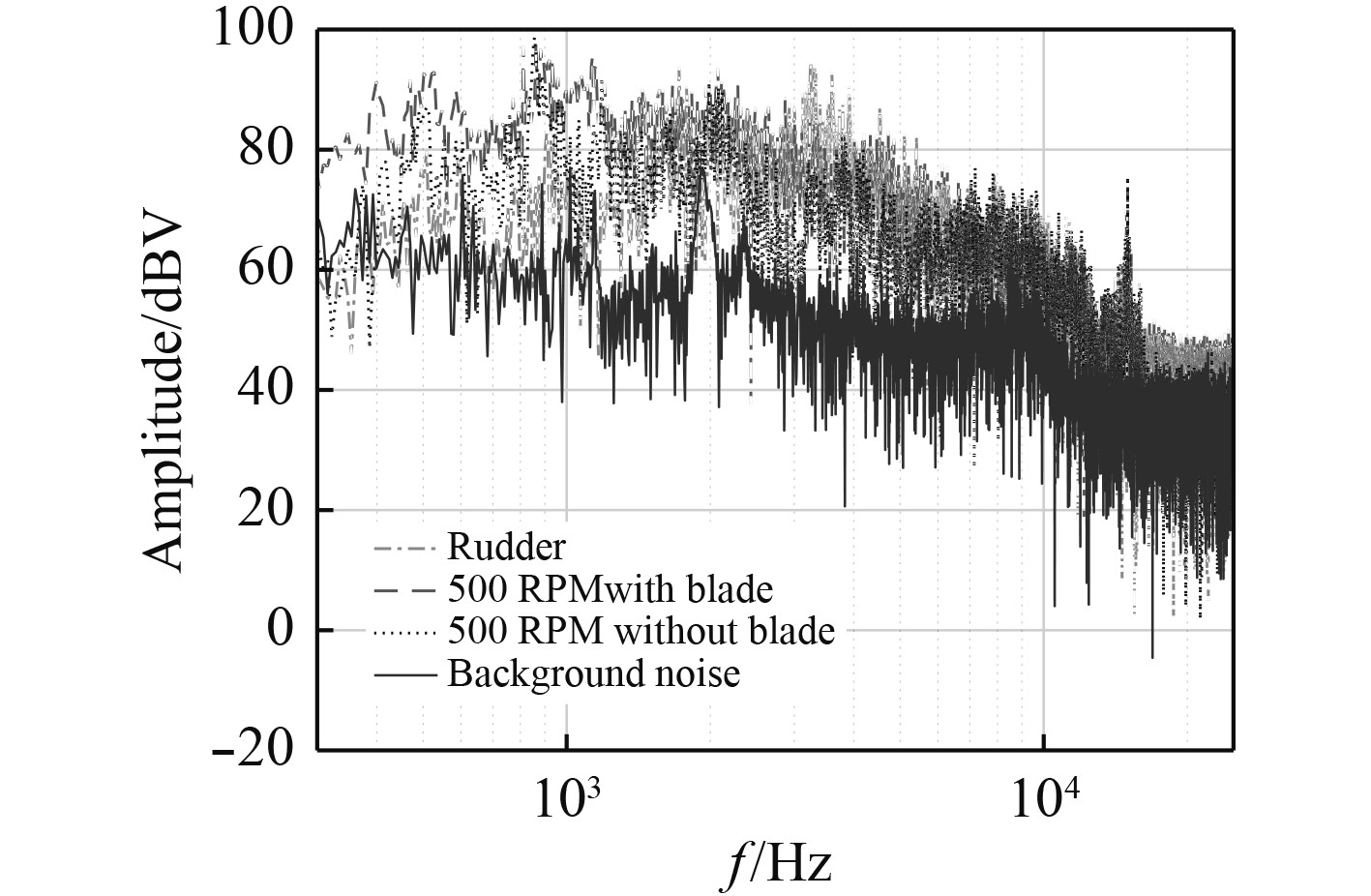
|
图 7 AUV静止状态下湖上噪声测试,背景噪声,未安装螺旋桨的噪声,安装螺旋桨后的噪声;舵机转动的噪声 Fig. 7 AUV noise test on the lake in a static state, background noise, noise without propeller installed, noise after propeller installed; noise from steering gear rotation |
湖上航行试验主要对AUV工作状态下总体噪声进行测试,即AUV以平均航速3 kn航行,航行深度10 m,利用搭载在AUV上的水听器及数据采集系统记录噪声,比较AUV正常航行,以及经过智能噪声控制后的噪声特性。智能噪声控制指根据测量任务,优化转舵方式,优化电机控制,但不影响整体航行及测量。噪声测试结果如图8所示。在正常航行情况下,AUV噪声较大,在低频处噪声大于100 dB;当进行智能噪声控制后,噪声幅度明显减小,1 kHz以上频率除个别频点外基本控制在80 dB以下。个别频点可能是测试环境中有其他信号的干扰,需要进一步验证。
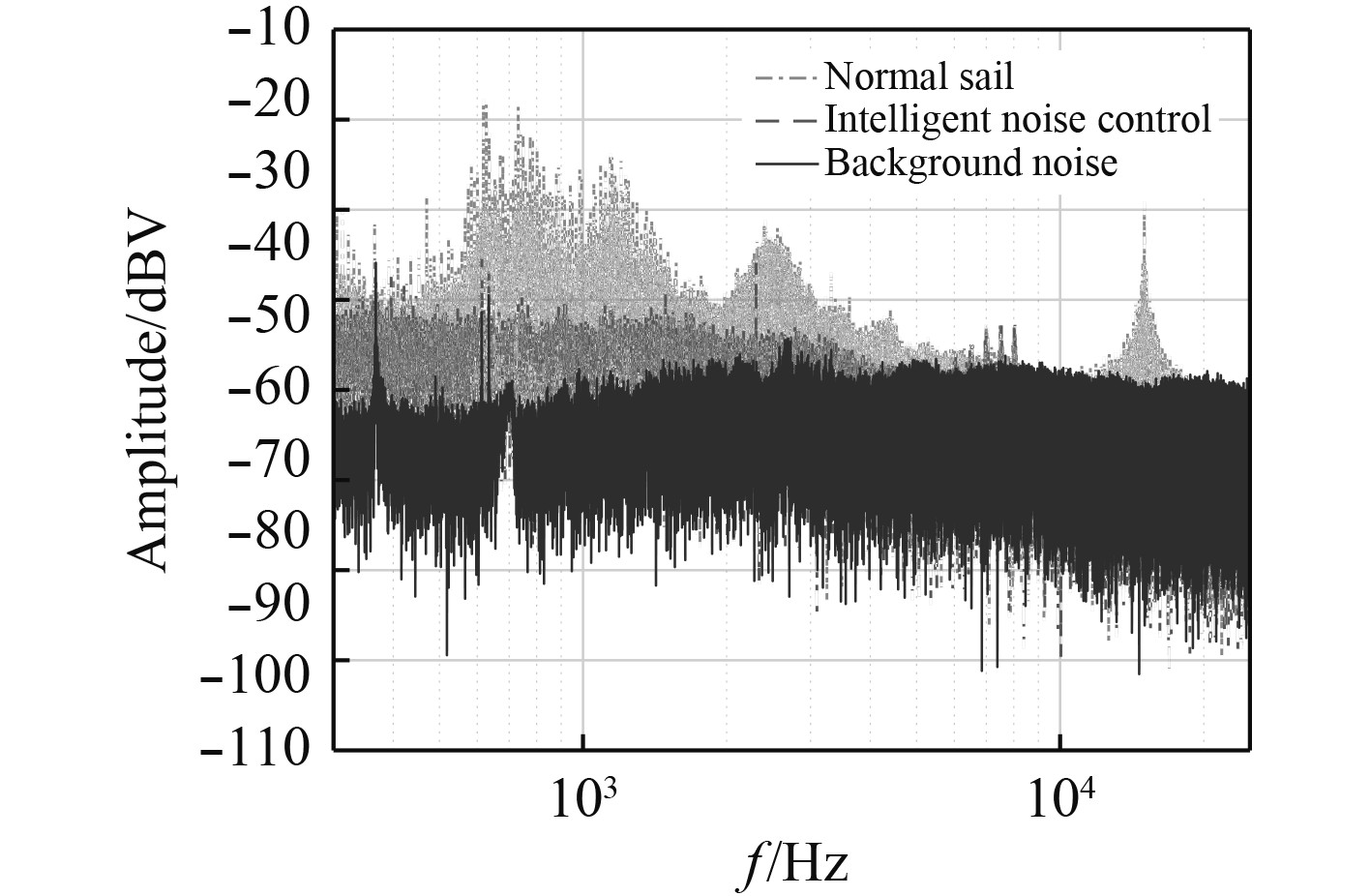
|
图 8 AUV湖上航行噪声测试,背景噪声,智能噪声控制后的结果,正常航行的噪声 Fig. 8 AUV noise test on the lake in sailing mode; background noise, the result of intelligent noise control, noise without intelligent noise control |
本文主要对AUV推进系统自噪声进行分析,提出自噪声控制方法,通过隔振材料和吸声材料的应用,降低推进器电机的噪声;通过减小联轴器与电机及螺旋桨的安装间隙,降低联轴器等传动装置引入的噪声;通过优化转舵控制方式,减小舵机转动时的噪声;通过优化推进系统控制方式,降低AUV工作时的噪声。通过室内及湖上测量,验证了降噪措施的有效性。湖上试验结果表明,在典型平均航速为3 kn情况下,平台自噪声1 kHz以上频段可控制在80 dB以下。
| [1] |
ALLEN B, STOKEY R, AUSTIN T, et al. REMUS: a small, low cost AUV; system description, field trials and performance results[C]. Oceans conference, Halifax, 1997: 994–1000.
|
| [2] |
CRUZ N, MATOS A. The MARES AUV, a modular autonomous robot for environment sampling[C]. Oceans conference, Quebec City, 2008: 1–6.
|
| [3] |
MOLINE M A, BLACKWELL S M, VON Alt C, et al. Remote environmental monitoring units: an autonomous vehicle for characterizing coastal environments[J]. Journal of Atmospheric and Oceanic Technology, 2005, 22(11): 1797-1808. DOI:10.1175/JTECH1809.1 |
| [4] |
ZHANG Ming, XU Yuan-xin, LI Bo, et al. A modular autonomous underwater vehicle for environmental sampling: system design and preliminary experimental results[C]. Oceans conference, Taipei, 2014: 1–5.
|
| [5] |
ZHANG Y, BELLINGHAM J G, GODIN M, et al. Using an autonomous underwater vehicle to track the thermocline based on peak-gradient detection[J]. IEEE Journal of Oceanic Engineering, 2012, 37(3): 544-553. DOI:10.1109/JOE.2012.2192340 |
| [6] |
YOKOTA S, KIM K, IMASATO M, et al. Development and sea trial of an autonomous underwater vehicle equipped with a sub-bottom profiler for surveying mineral resources[C], IEEE/OES Autonomous Underwater Vehicles, Tokyo, 2016, 81–84.
|
| [7] |
ZHANG Ming, XU Wen, and XU Yuan-xin. Inversion of the sound speed with radiated noise of an autonomous underwater vehicle in shallow water waveguides[J]. IEEE Journal of Oceanic Engineering, 2016, 41(1): 204-216. DOI:10.1109/JOE.2015.2418172 |
| [8] |
段勇, 郭君, 周凌波. 隔振技术在水下航行器推进轴系振动控制中的应用[J]. 水下无人系统学报, 2018, 26(1): 70-77. DUAN Yong, GUO Jun, ZHOU Ling-bo. Application of virbration isolation technology to vibration control of undersea vehicle propulsion shafting[J]. Journal of unmaned undersea systems, 2018, 26(1): 70-77. |
| [9] |
郭凯红, 李健, 李星升. 水下航行器推进系统机械噪声与辐射噪声相关性分析及方法研究[J]. 机械管理开发, 2010, 25(6): 114-116. GUO Kai-hong, LI Jian, LI Xing-sheng. The relevance study between mechanical noise and radioactive noise of the propulsion system of undersea vehicles[J]. Mechanical management and development, 2010, 25(6): 114-116. DOI:10.3969/j.issn.1003-773X.2010.06.061 |
| [10] |
陈健松. 某水下航行体自噪声特性研究[D]. 西安: 西北工业大学, 2002. CHEN Jian-song. The study of self-noise characteristic of one under-water vehicle[D]. Xi′an: Northwestern Polytechnical University, 2002. |
 2020, Vol. 42
2020, Vol. 42

